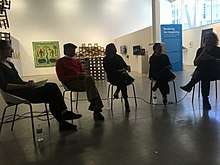Scherezade García

Scherezade García (sometimes Scherezade García Vasquez) (born 1966) is a painter, printmaker and installation artist from the Dominican Republic currently based in New York City.[1]
Early life and education
Born in Santo Domingo,[2] García was active in visual arts from the time she was a girl.[3] In 1986 she received a full merit scholarship from Parsons, the New School for Design in New York City; she has been based in that city ever since. She had received her AAS from the Altos de Chavón School of Design, a Parsons affiliate, in La Romana, in her home country. After receiving her BFA from Parsons, she received an MFA from the City College of New York.
Career
She has since served on the faculty of Parsons.[4] In 2015 she received a career grant from the Joan Mitchell Foundation. A co-founder of the Dominican York ProyectoGráfica, García is a member of the advisory board of No Longer Empty.[5]
Much of García's work deals with themes relating to immigration and the desire to belong in a new country;[4] she has stated that her interest lies in the Caribbean, especially the Hispanic diaspora,[3] and her pieces are informed by aspects of her black and European heritage.[6] Four of her mixed-media works are in the collection of the Smithsonian American Art Museum.[7][8][9][10] Other works may be found in the collections of El Museo del Barrio, the Housatonic Museum of Art, and the Museo de Arte Moderno Santo Domingo.[4]
Selected Works
Paradise Redefined, at the Lehman College Art Gallery, December 2006, a sculptural installation of tent like structures covered with images of Dominican tenant buildings and bodegas, with light, street sounds and fragments of Spanish language emanating from within. Intermittently breaking wave sounds add to the mix coming from a mural size beach scene."The installation is concerned with issues of identity and homeland, and the expectations of a better life, which often characterize stories of migration to the United States." said Benjamin Gennochio critic for the New York Times.[1]
Transit/Liquid Highway, September 2015, exhibited in the lobby of Columbia University'a Wallach Art Gallery Miller Theatre, is a site-specific mural explores the relationship between the Dominican Republic and immigrants new homeland. Large images of waves and found objects both intermix losses and gains of migration[11]
Hurricane Sandy Altar, 2013, is a painting featured in an essay by Abigail Lapin Dardashti titled El Dorado: the Neobaroque in Dominican American Art, focusing the use of gold by Dominican artists who subvert myths and dreams constructed by imperialist and neocolonialist economic and political systems [12]
References
- 1 2 Genocchio, Benjamin (2006-12-17). "With Expectations of a Better Life". The New York Times. ISSN 0362-4331. Retrieved 2018-03-18.
- ↑ "Scherezade García". Smithsonian American Art Museum. Retrieved 3 March 2018.
- 1 2 http://serieproject.org/artist-in-residence-spotlight-scherezade-garcia/
- 1 2 3 "Scherezade Garcia - Bios - Miller Theatre at Columbia University". www.millertheatre.com. Retrieved 3 March 2018.
- ↑ "Scherezade Garcia". Joan Mitchell Center. Retrieved 3 March 2018.
- ↑ "Dominican Art History: 10 Trailblazing Female Artists You Should Know". Retrieved 4 March 2018.
- ↑ "Santo Trujillo is Dead, from the series Island of Many Gods". Smithsonian American Art Museum. Retrieved 3 March 2018.
- ↑ "Day Dreaming/Soñando despierta, from the portfolio Manifestaciones". Smithsonian American Art Museum. Retrieved 3 March 2018.
- ↑ "The Dominican York, from the series Island of Many Gods". Smithsonian American Art Museum. Retrieved 3 March 2018.
- ↑ "La Guadalupe". Smithsonian American Art Museum. Retrieved 3 March 2018.
- ↑ "Scherezade Garcia: In Transit/Liquid Highway". Wallach Art Gallery | Columbia University. 2017-02-17. Retrieved 2018-04-05.
- ↑ Dardashti, Abigail Lapin (2017-05-11). "El Dorado: The Neobaroque in Dominican American Art". Diálogo. 20 (1): 73–87. doi:10.1353/dlg.2017.0007. ISSN 2471-1039.